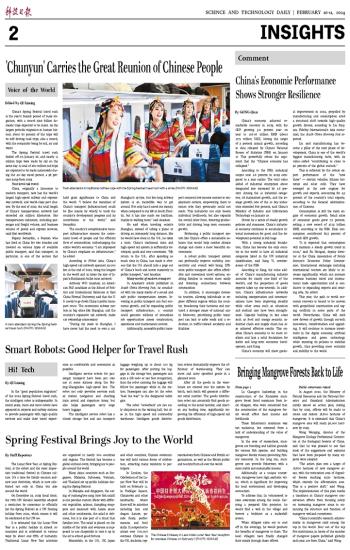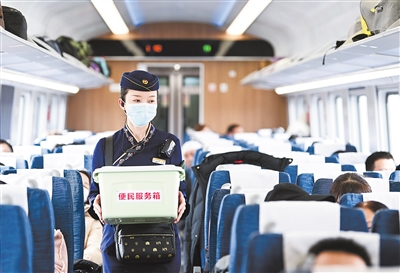
 |
| Train attendants in traditional clothes cope with the Spring Festival travel rush with a smile. (PHOTO: XINHUA) |
 |
| A train attendant during the Spring Festival travel rush. (PHOTO: XINHUA) |
China's Spring Festival travel rush is the year's busiest period of mass migration, with a record nine billion domestic trips expected to be made. As the largest periodic migration in human history, about 80 percent of the trips will be self-driving road trips, also a record, with the remainder being by rail, air and water.
The Spring Festival travel rush kicked off on January 26, and nearly 11 million trips were made by rail on the same day. A total of 480 million rail trips are expected to be made nationwide during the 40-day travel period, a 38 percent jump from 2023.
Next-level rail travel
China, originally a latecomer to modern transport, now has the world's largest high-speed railway and expressway network, and world-class port clusters. By the end of 2022, the total length of China's transportation network had exceeded six million kilometers. Key transportation indicators, including passenger and freight volume, and business volume of postal and express services, rank first worldwide.
Evgeny Semaykin, a Russian who has lived in China for two decades and traveled on various types of available public transport, said that transport, in particular, is one of the sectors that hold great significance to China and the world. "I believe the transition of China's transport [infrastructure] could be [the means by which] to track the country's development progress and its contribution to the world," said Semaykin.
The country's comprehensive transport infrastructure ensures the convenient travel of people and the efficient flow of commodities, turbocharging the entire world's economy. "I am impressed by China's emphasis on infrastructure," he added.
According to Nikkei Asia, China's high-speed rail network spanned 42,000 km at the end of 2022, being the longest in the world and 13 times the size of Japan's Shinkansen bullet train network.
Anthony W.D. Anastasi, an American PhD candidate at the School of Politics and International Relations at East China Normal University, said that the U.S. needs to go down China's public transport route. The convenient subway system in big cities like Shanghai, and the country's expansive rail network, make car ownership unnecessary.
"During my years in Shanghai, I have never had the need to own a car. Shanghai's 19-line, 802 km-long subway system is an incredible way to get around. Not only has it saved me money, when compared to my life in South Florida, but it has also made me healthier, thanks to walking more," said Anastasi.
He said when traveling outside Shanghai, instead of taking a plane or driving an immensely long distance, like he would have done in the U.S., he takes a train. China's traditional train and high-speed rail system is sufficiently developed, quick and very convenient. "My return to the U.S., after spending so much time in China, has made it obvious that the U.S. should take a page out of China's book and invest massively in public transport," said Anastasi.
Many merits of modern transport
In Anastasi's article published in South China Morning Post, he concluded with the many merits of a sound and safe public transportation system. Investing in public transport can fuel economic growth, and by expanding public transport infrastructure, a country could generate millions of immediate job opportunities across construction, operations and maintenance sectors.
Additionally, accessible public transport connects low-income earners to employment centers, empowering them to secure jobs they previously could not reach. This inclusivity not only boosts individual livelihoods, but also expands the overall labor force, fostering productivity and driving long-term economic growth.
Embracing a public transport system like China's offers a sustainable solution that would help combat climate change and create a more beautiful environment.
A robust public transport system can profoundly improve mobility, connectivity and overall well-being. Efficient public transport also offers affordable and convenient travel options, enabling families to reunite more easily and fostering connections between communities.
In addition, it encourages domestic tourism, allowing individuals to explore different regions within the country, broadening their horizons and nurtured a stronger sense of national unity. Moreover, prioritizing public transport can lead to safer roads and a reduction in traffic-related accidents and fatalities.


 Next
Next




